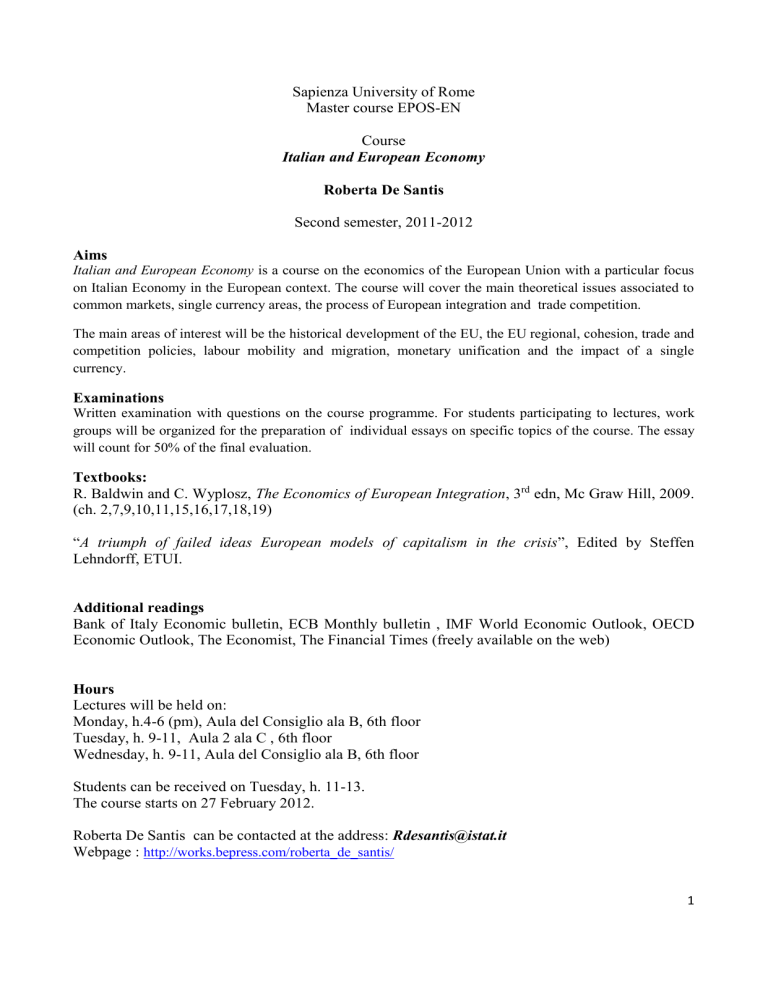
Sapienza University of Rome
Master course EPOS-EN
Course
Italian and European Economy
Roberta De Santis
Second semester, 2011-2012
Aims
Italian and European Economy is a course on the economics of the European Union with a particular focus
on Italian Economy in the European context. The course will cover the main theoretical issues associated to
common markets, single currency areas, the process of European integration and trade competition.
The main areas of interest will be the historical development of the EU, the EU regional, cohesion, trade and
competition policies, labour mobility and migration, monetary unification and the impact of a single
currency.
Examinations
Written examination with questions on the course programme. For students participating to lectures, work
groups will be organized for the preparation of individual essays on specific topics of the course. The essay
will count for 50% of the final evaluation.
Textbooks:
R. Baldwin and C. Wyplosz, The Economics of European Integration, 3rd edn, Mc Graw Hill, 2009.
(ch. 2,7,9,10,11,15,16,17,18,19)
“A triumph of failed ideas European models of capitalism in the crisis”, Edited by Steffen
Lehndorff, ETUI.
Additional readings
Bank of Italy Economic bulletin, ECB Monthly bulletin , IMF World Economic Outlook, OECD
Economic Outlook, The Economist, The Financial Times (freely available on the web)
Hours
Lectures will be held on:
Monday, h.4-6 (pm), Aula del Consiglio ala B, 6th floor
Tuesday, h. 9-11, Aula 2 ala C , 6th floor
Wednesday, h. 9-11, Aula del Consiglio ala B, 6th floor
Students can be received on Tuesday, h. 11-13.
The course starts on 27 February 2012.
Roberta De Santis can be contacted at the address: [email protected]
Webpage : http://works.bepress.com/roberta_de_santis/
1
Programme
No.
1.
2.
3.
February
27
Introduction to the course and test for students
28 am Essential macroeconomic tools
Baldwin-Wyplosz,ch. 9
29
Exchange rates and Balance of Payments
Baldwin-Wyplosz,ch.10
4.
5.
6.
7.
March
5
Understanding economic growth in Europe (Pianta*)
6 am The first wave of European integration (Pianta)
6 pm The second wave of European integration (Pianta)
7
European institutions, law and budget (Pianta)
Baldwin-Wyplosz,ch.2
8.
12
9.
10.
Monetary integration and optimum currency areas
Baldwin-Wyplosz,ch.10
13 am The European monetary system
Baldwin-Wyplosz,ch.16
14
The European monetary system cont.
Baldwin-Wyplosz,ch.16
11.
12.
13.
14.
19
The success of Europe’s growth (Pianta)
20 am The problems of Europe’s growth (Pianta)
20 pm The slowdown of Europe’s growth (Pianta)
21
The slowdown of Europe’s growth (Pianta)
15.
16.
17
26
The Italian Economy: the past decade (Laboratory)
27 am The Italian Economy: an international comparison within the EU (Laboratory)
28
Organization of work groups on course topics (Laboratory)
17.
18.
19.
April
2
The European Monetary Union
Baldwin-Wyplosz,ch.17
3am The European Monetary Union
Baldwin-Wyplosz,ch.17
4
The European Monetary Union (Laboratory)
(Easter Break)
20.
*
16
Europe’s fiscal policy
Some lectures are in common with the course European Economics held by Prof. Mario Pianta
2
21.
Baldwin-Wyplosz,ch.18
20 am European economic policy in the last decade
22
21
Europe’s trade policy
Baldwin-Wyplosz, ch.15
23.
24.
25.
26.
23
24
26
27
Advanced course on innovation and growth (Seminars)
Advanced course on innovation and growth
Advanced course on innovation and growth
Advanced course on innovation and growth
27.
30
Europe’s trade policy cont.
Baldwin-Wyplosz, ch.15
28.
May
2
29
30.
31.
32.
7
8 am
8 pm
9
33.
34.
35.
14
Working groups presentations
15 am Work groups presentations
16
Conclusion of the course
Europe and financial markets
Baldwin-Wyplosz, ch.19
The crisis in Europe and in Italy
The crisis in Europe and in Italy
The crisis in Europe and in Italy
Working groups presentations
3
